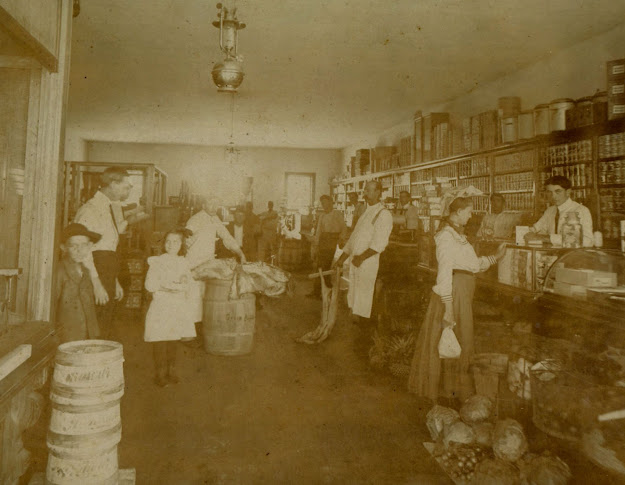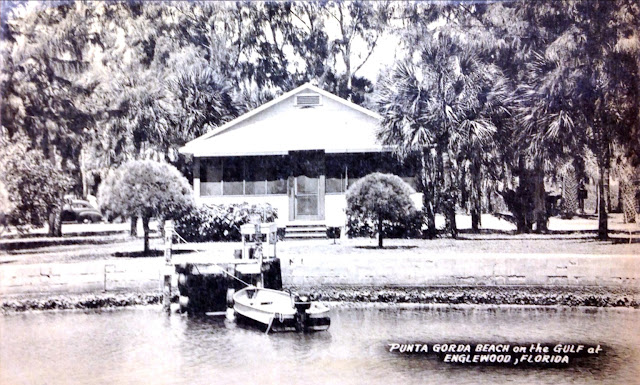Wednesday, June 24, 2020
Jacob Wotitzky - Punta Gorda’s First Retailer
Thursday, June 18, 2020
The Herald Building Once on the Corner of Marion and Taylor
 |
| Herald Building Circa 1907 |
Fires involving wood buildings were frequent in the early 1900s throughout the United States. In Punta Gorda one of the bigger fires at that time was a 1905 fire that destroyed an entire block in the business district on West Marion Avenue.
Rebuilding the district took several years. One of the first buildings to be constructed was the two-story stucco building at 149 W. Marion Ave. believed to have been built in 1907. A picture of the building in Vernon Peeples book, Punta Gorda and the "Charlotte Harbor Area - A Pictorial History," shows the building in 1907.
The building was constructed to house the Punta Gorda Herald and retail stores on the first. A dry goods store owned by the Chadwick Brothers occupied the first floor for a time. The newspaper moved into the second story of the building, but the large presses used to print the newspaper, made such a racket that the whole building shook. The Herald then built a little building in the alley way (Herald Court area) for the presses.
 |
| Marion and Taylor 1921 (During Hurricane) |
About 1913 the Punta Gorda Herald relocated and the second floor was leased to the Inter-County Phone Company, while the first floor housed a drug store and Cooper’s Hardware Store on the corner. According to Byron Rhodes’ book a pool room occupied part of the space around this time.
 |
| Marion and Taylor 1930s |
Various businesses occupied the space over time. In the late 1920s Fred Quednau opened a luncheonette on the first floor of the building. Fred's Quick Lunch closed around 1938 and J.T. Lawhorn's Grocery moved in. Tosie Quednau Hindman, the daughter of Fred Quednau, worked at Lawhorn's during World War II. She also worked next door at her Uncle Bill's Bar.
For many years the second floor of the building was vacant. In 2002 the first floor was occupied by Kountry Klub Kollectibles. The building was badly damaged in Hurricane Charley in 2004 and torn down shortly thereafter. Today there is a vacant lot there.
Prepared by Theresa Murtha
(From the research notes of Vernon Peeples, recollections of U.S. Cleveland as reported in an article by Ann Henderson, Herald Tribune 2002, Byron Rhode's Punta Gorda Remembered and photo collection held at the Punta Gorda History Center)
Tuesday, June 9, 2020
Tosie Quednau Hindman - Growing up in the Quednau House
Punta Gorda Beach and the Incredible Story of the Chadwicks of Punta Gorda and Lemon Bay
There was once a Punta Gorda Beach on the gulf. In the 1930s the Charlotte County chamber was looking for ways to draw more tourists to the area. An investor in the then Chadwick Beach now Englewood Beach wanted to sell and rent cottages on that beach to more affluent Punta Gordans. Punta Gorda Beach was born and for more that twenty years became the go-to-the-beach experience for local Punta Gordans. Day trips, group picnics and shore vacations were regularly announced in the local paper much like Facebook posts of today. Many prominent families owned cottages there.
Wednesday, June 3, 2020
The Transition of the Punta Gorda Waterfront into a Beautiful Park
Prior to 1914, the Punta Gorda shoreline of Charlotte Harbor ran in its natural state to within a few hundred feet of Retta Esplanade. Refuse washed ashore. Flooding was an issue, as was erosion. It wasn’t always pretty.
Beginning in 1912, a group of citizens led by Dr. George Stone ( a Punta Gorda Mayor) came up with the idea to build a concrete seawall along the waterfront from Taylor Street to Berry Street, fill in behind it, and create a waterfront park filled with rare and beautiful tropical plants. To finance the project, they would create and sell waterfront lots, so they promised the new park project wouldn’t cost the city taxpayers a cent.
Many laughed at the idea and told Stone it was crazy idea and couldn’t be accomplished. Undaunted, he developed a plan and presented it to the City Council, who agreed with the project, and it went forward.
The construction project was a big success. Unfortunately for the developers, neither Dr. Stone and his partners nor the city had considered Isaac Trabue’s original instructions in platting the Town of Trabue, which was to become Punta Gorda. The deed specifies that all the waterfront be designated as public parks. Title to the newly created property could not be conveyed to the interested buyers, who were intended to pay for the entire project.
After 10 years of litigation between the bank that financed the project, Dr. Stone and his fellow property investors, and the City of Punta Gorda, a settlement was reached. The City would pay the cost of building the seawall and filling the land, and thereby own it free of all encumbrances. All parties were satisfied.
Today, we all owe a debt of gratitude, both to Isaac Trabue for his thoughtfulness in creating the town of Trabue required the waterfront would be protected for use by all its citizens, and to Dr. Stone for his efforts to create a beautiful waterfront, which didn’t work out quite as he originally planned, but which resulted in our beautiful Harborwalk parks. I have to believe that both would be pleased with the result.
(J. Dodez)








